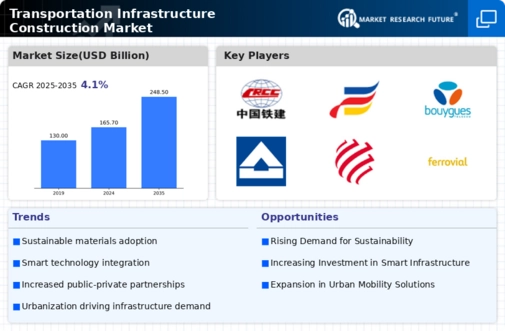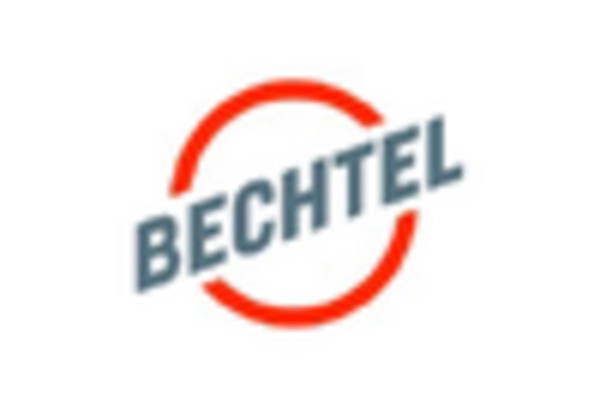Increased Urbanization
The ongoing trend of urbanization appears to be a primary driver for the Transportation Infrastructure Construction Market. As populations migrate towards urban centers, the demand for efficient transportation systems intensifies. This urban growth necessitates the expansion and modernization of roads, bridges, and public transit systems. According to recent data, urban areas are expected to house approximately 68 percent of the world's population by 2050, which could lead to a substantial increase in infrastructure investment. Consequently, governments and private entities are likely to allocate significant resources to enhance transportation networks, thereby stimulating growth within the Transportation Infrastructure Construction Market.
Technological Advancements
Technological advancements are reshaping the Transportation Infrastructure Construction Market in profound ways. Innovations such as Building Information Modeling (BIM), drones, and advanced materials are enhancing project efficiency and safety. The integration of smart technologies into infrastructure projects is becoming increasingly prevalent, allowing for better monitoring and maintenance of transportation systems. For example, the use of sensors and IoT devices can provide real-time data on traffic patterns and structural integrity. This technological evolution is expected to streamline construction processes and reduce costs, thereby attracting more investments into the Transportation Infrastructure Construction Market.
Government Investment in Infrastructure
Government investment in infrastructure development is a crucial factor influencing the Transportation Infrastructure Construction Market. Many governments are prioritizing infrastructure projects to boost economic growth and improve public services. For instance, in recent years, several countries have announced multi-billion dollar infrastructure plans aimed at upgrading transportation systems. This trend is expected to continue, with projected spending on transportation infrastructure reaching trillions of dollars over the next decade. Such investments not only create jobs but also enhance connectivity, which is vital for economic development. Therefore, the commitment of governments to infrastructure spending is likely to drive the Transportation Infrastructure Construction Market forward.
Rising Demand for Public Transportation
The rising demand for public transportation systems is a notable driver of the Transportation Infrastructure Construction Market. As urban populations grow, the need for efficient and reliable public transit options becomes more pressing. Many cities are investing in expanding their public transportation networks to alleviate traffic congestion and reduce carbon emissions. Recent data suggests that investments in public transit can yield significant economic returns, with every dollar spent generating approximately four dollars in economic returns. This trend indicates a robust market potential for transportation infrastructure projects focused on public transit, thereby propelling the Transportation Infrastructure Construction Market.
Environmental Regulations and Sustainability
The growing emphasis on environmental regulations and sustainability is significantly impacting the Transportation Infrastructure Construction Market. As concerns about climate change and environmental degradation rise, governments and organizations are increasingly adopting sustainable construction practices. This shift includes the use of eco-friendly materials and energy-efficient designs in transportation projects. Recent studies indicate that sustainable infrastructure investments could lead to a reduction in greenhouse gas emissions by up to 30 percent. Consequently, the demand for sustainable solutions in transportation infrastructure is likely to drive innovation and investment in the Transportation Infrastructure Construction Market.

















Leave a Comment